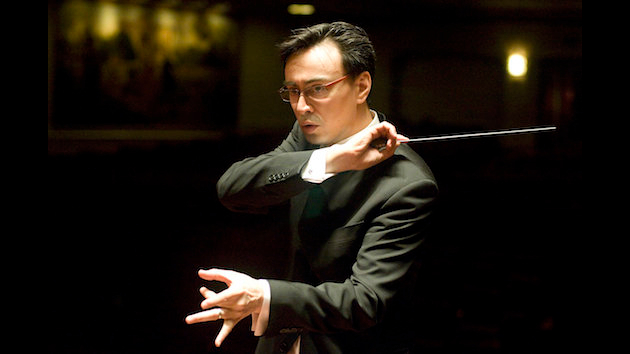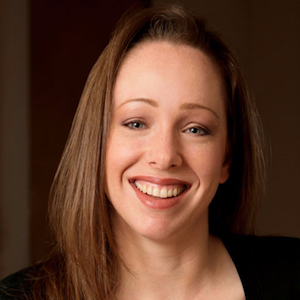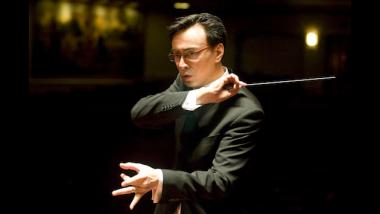
Thursday, April 19 was a big night for the Berkeley Symphony. For its season-ending concert, the orchestra filled Zellerbach Hall for that monumental undertaking — Beethoven’s Ninth. In addition to four estimable soloists, the organization enlisted four different choral ensembles for the “Ode to Joy.” The stage looked like a crowd scene from a Cecil B. DeMille extravaganza, the space filled upstage to down and wing to wing.
There was more. Ken-David Masur, son of the famed maestro Kurt Masur (1927–2015), took the podium as guest conductor. The concert was fondly dedicated to the late Marcos F. Maestre, a stalwart supporter whose widow, Janet Maestre, played flute in the ensemble for decades. A new logo brand, featuring a kind of stylized “B-clef” (as in “Berkeley Symphony”), festooned free canvas tote bags for all comers.
In both its details and broader darkness-to-light dimensions, this Beethoven Ninth fell well short of the immediacy, wonderment, and hard-won triumph the great work summons.Given all the good feeling, capped by a sustained ovation, it would be a happy duty to report that the performance lived up to the heightened expectations. Unfortunately, despite some felicities — dramatic peaks and an impressively mighty choral sound — it was not to be. In both its details and broader darkness-to-light dimensions, this Beethoven Ninth fell well short of the immediacy, wonderment, and hard-won triumph the great work summons.
The uncertainties began early on, in an opening Allegro that failed to generate the sense of mysterious apprehension and gathering force the movement conveys in its unsettling explorations. Masur elicited phrases that were so cleanly and crisply uttered as to seem remote and uncharacterized. Things improved somewhat in the development section, with more vibrant strings and some thunderclap climaxes. But the horns came in sourly. The woodwinds sounded tentative. Ragged and patchy playing persisted.
Masur set the Scherzo in motion with a ticking energy. Here his instinct for precision, conveyed in his explicit cues, seemed well placed. The nimbleness carried from section to section, strings to woodwinds to brass. The bassoons burbled happily. An easy flow took hold, only to dissipate in the middle section, where the composer’s lilting, dance-like figures remained sedentary and largely charmless. Timpanist Kevin Neuhoff worked a beguiling echo effect in both outer sections of the movement.
The violas bloomed warmly in the Adagio. The woodwinds offered some of their tenderest and most attractive work of the night. While a certain blandness descended, there were also passages of sunlit illumination. Masur, conducting without the baton he employed earlier, opened up a more rounded and involving approach here.
The soloists had entered before the Adagio began, poised as an audience always is for the concussive, ebullient, and exultant Finale. In its nervous recall of fragments from the three preceding movements, this last one has a deep-seated restlessness. The Berkeley players captured that aspect well, with a kind of muttering instability. But when the cellos show the way forward with the movement’s sublime principal theme, it came off glumly, almost perfunctorily. The air went out of the room.

The singing, the jolly cymbal-and-bass drum march, and double fugues are almost sure to get the listeners pumped. Masur made sure of it, with some heavy-handed dynamics and fleet tempos. Bass Adam Lau piled on, at his vaulting first entrance in “O Freunde, nicht diese Töne,” sounding out the cry for “no more of these sounds” with a heavily tremulous one of his own. Mezzo-soprano Michelle Rice made a vivid imprint, as did Laquita Mitchell, both of them soaring through the musical torrents. Tenor Amitai Pati underwhelmed by comparison.
When the chorus kicked in, they did so with a big wall-of-sound impact. It may not have been the supplest performance, but entrances and exits were sharp, and the sound reverberated. The UC Berkeley University Chorus, Chamber Chorus of the University of California, alumni of both those organizations, and select members of the Berkeley Community Chorus & Orchestra teamed up.
Long, lean, and upright, Masur conveyed a clear sense of purpose. He gave a clear beat, repeatedly pointed to his players for emphasis, and appeared to be lip-synching the vocal parts. As confident as he seemed, it might be that he didn’t connect fully with the orchestra in whatever rehearsal time they had.
Everything about the evening had you rooting for this appealing conductor, the throng of performers, and an organization staging a major event. Wishes, in this case, only fitfully came through.




